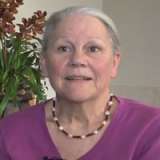Robotic Surgery to Correct Pelvic-Organ Prolapse
Find Your Care
Whether you need a preventative examination, pregnancy care or treatment for a gynecological condition, our OB/GYN specialists are here for you. Call 310-794-7274 to schedule an appointment today.
Pam’s Story: Pelvic-Organ Prolapse Robotic Surgery
Pelvic-organ prolapse is a fairly common condition that affects some 50 percent of all women in the United States as they age. For Pam McFarlane, the feeling was like “your internal organs are about to fall out onto the sidewalk.”

The problem occurs when the vaginal wall, which supports adjoining organs including the vagina, uterus, bladder and rectum, weakens. “Life events such as childbirth, occupations, even genetics, can contribute to weaknesses or deficiencies in the support of the bladder and the rectum and uterus,” explains gynecologist Christopher Tarnay, M.D.
To correct the condition, Pam underwent a laparoscopic, robotic procedure to sew in thin mesh straps to secure the anatomy in its proper place. “The robot allows us excellent three-dimensional visualization and allows us to reproduce the intricate movements of our hand, which allows us to avoid a large abdominal incision,” Dr. Tarnay says. That, in turn, reduces the period of hospitalization and recovery, as well as pain and medication requirements.

After surgery, Pam spent the night at UCLA and went home the next day. “The biggest surprise for me was how great I felt immediately,” she says. “The second day I felt like doing cartwheels. I took exactly one dose of pain meds the first day. I never took anymore pain medication. I just felt great.”
Often embarrassment or concern about large surgeries prevent women from seeking care, but Dr. Tarnay emphasizes that it is important for women to know that they don’t have to suffer with the condition in silence.
As Pam recalls her conversation with Dr. Tarnay, who said to her: “’I have a plan and we can fix all of this. It’s fixable.’ And he was right, it was all fixable.”